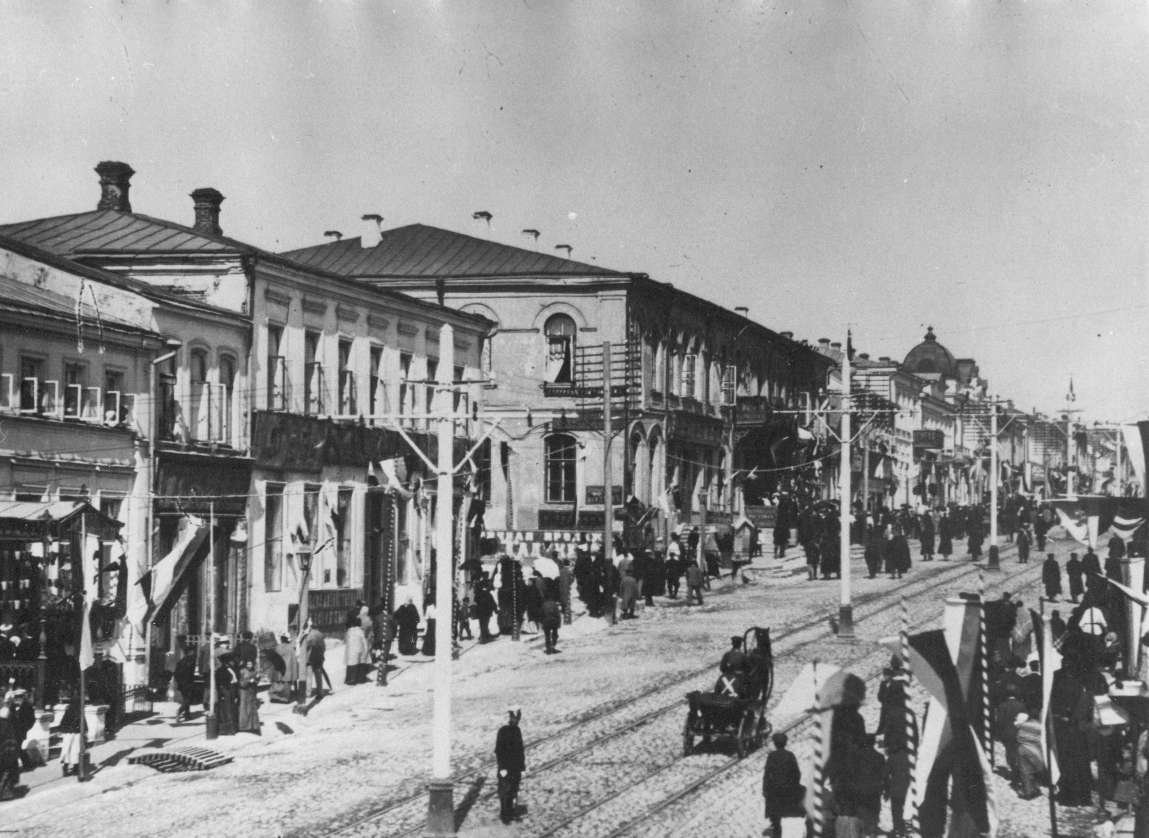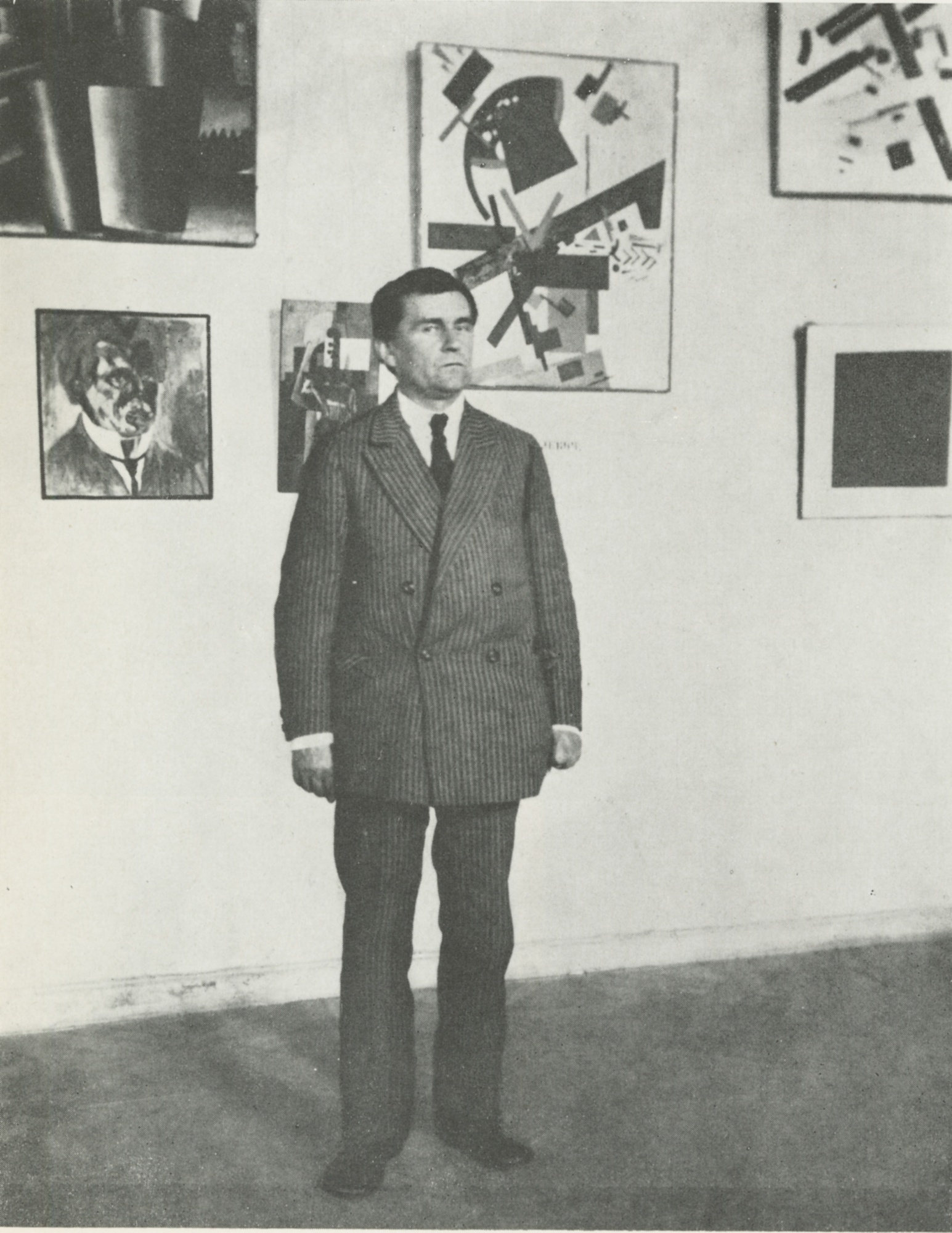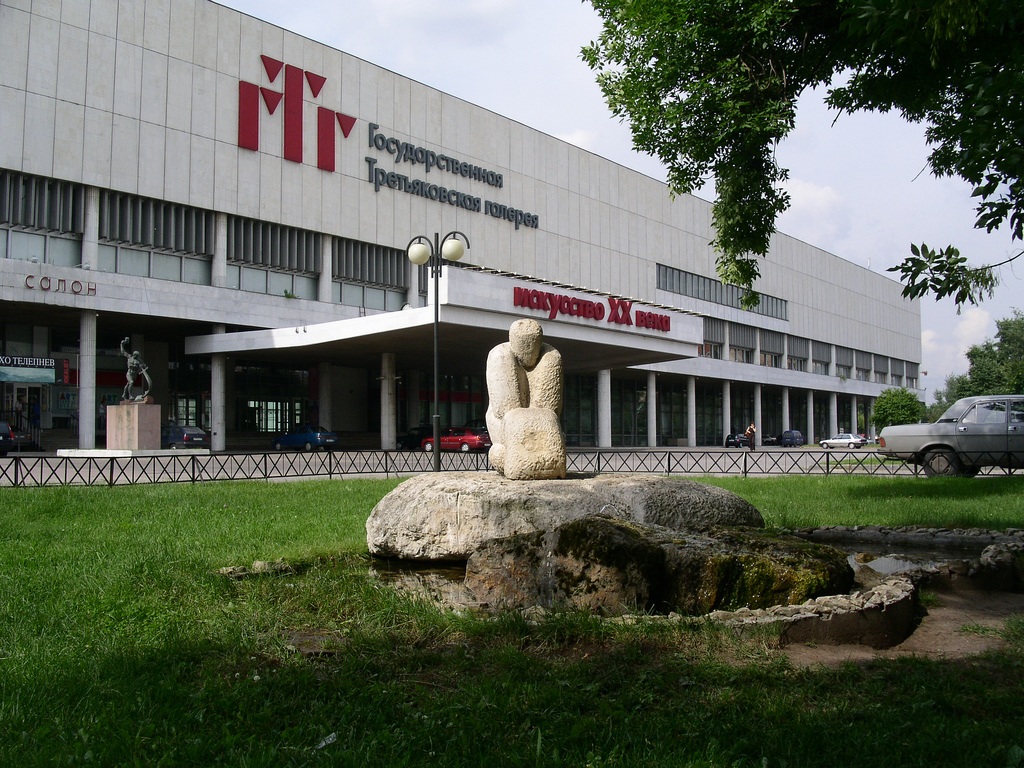|
Nadezhda Udaltsova
Nadezhda Andreevna Udaltsova (, 29 December 1885 – 25 January 1961) was a Russian avant-garde artist ( Cubist, Suprematist), painter and teacher. Early life and education Nadezhda Udaltsova was born in the city of Orel, Russia, on 29 December 1885. When she was six, her family moved to Moscow, where she graduated from high school and began her artistic career. In September 1905 Udaltsova enrolled in the art school run by Konstantin Yuon and Ivan Dudin, where she studied for two years and met fellow-students Vera Mukhina, Liubov Popova, and Aleksander Vesnin. In the spring of 1908 she traveled to Berlin and Dresden, and upon her return to Russia, she unsuccessfully applied for admission to the Moscow Institute of Painting, Sculpture, and Architecture. She also married Alexander Udaltsov, her first husband, in 1908. In 1910–11, Udaltsova studied at several private studios, among them Vladimir Tatlin's. In 1912–13 she and Popova traveled to Paris to continue their studi ... [...More Info...] [...Related Items...] OR: [Wikipedia] [Google] [Baidu] |
Oryol
Oryol ( rus, Орёл, , ɐˈrʲɵl, a=ru-Орёл.ogg, links=y, ), also transliterated as Orel or Oriol, is a Classification of inhabited localities in Russia, city and the administrative center of Oryol Oblast, Russia, situated on the Oka River, approximately south-southwest of Moscow. It is part of the Central Federal District, as well as the Central Economic Region. First founded as a medieval stronghold of the Principality of Chernigov, Oryol was part of Grand Duchy of Lithuania, Lithuania in the Late Middle Ages, late medieval period, and then Russia since the early modern period. It has served as the seat of regional administration since 1778. The city is particularly known for the infamous Oryol Prison, former prison for political and war prisoners of Russian Empire, Tsarist Russia, the Soviet Union and Nazi Germany. History Early history While there are no historical records, archaeological evidence shows that a fortress settlement existed between the Oka River and ... [...More Info...] [...Related Items...] OR: [Wikipedia] [Google] [Baidu] |
Alexander Udaltsov (historian)
Alexander Dmitriyevich Udaltsov (; – 25 September 1958) was a Russian medieval historian. Much of his writing concerns the medieval period in Western Europe, but he also wrote about the methodology of historical materialism, archeology and the ethnogenesis of the Slavs. In 1908, he married the artist Nadezhda Andreyevna Prudkovskaya. She was known throughout her career as Nadezhda Udaltsova, although she divorced David and married Alexander Drevin in 1919. He wrote about the Agrarian History of Carolingian Flanders criticising the views of the Austrian social and economic historian Alfons Dopsch. He argued that Dopsch overemphasized the presence of private land ownership and social inequality among pre-feudal German clans. Works "Происхождение славян"(Origin of the Slavs), ''Voprosy Istorii ''Voprosy Istorii'' (Russian: ''Вопросы истории'', translated ''Questions of History'') is a Russian academic journal for historical studies. It is pub ... [...More Info...] [...Related Items...] OR: [Wikipedia] [Google] [Baidu] |
Aleksandra Ekster
Aleksandra Aleksandrovna Ekster (née Grigorovich; ; ; 18 January 1882 – 17 March 1949), also known as Alexandra Exter, was a Russian and French painter and designer. As a young woman, her studio in Kiev attracted all the city's creative luminaries, and she became a figure of the Paris salons, mixing with Pablo Picasso, Picasso, Georges Braque, Braque and others. She is identified with the Russian/Ukrainian avant-garde, as a Cubo-Futurism, Cubo-futurist, Constructivism (art), Constructivist, and influencer of the Art Deco movement. She was the teacher of several School of Paris artists such as Abraham Mintchine, Yitzhak Frenkel, Isaac Frenkel Frenel and the film directors Grigori Kozintsev, Sergei Yutkevich among others. Early life She was born Aleksandra Aleksandrovna Grigorovich in Białystok, in the Grodno Governorate of the Russian Empire (now Poland) to a wealthy Belarusians, Belarusian family. Her father, Aleksandr Grigorovich, was a wealthy Belarusian businessman. Her ... [...More Info...] [...Related Items...] OR: [Wikipedia] [Google] [Baidu] |
Supremus
Supremus (; 1915–1916) was a group of Russian avant-garde artists led by the "father" of Suprematism, Kazimir Malevich. It has been described as the first attempt to found the Russian avant-garde movement as an artistic entity within its own historical development. Supremus conceptualized the artist as one who has freed himself from everything that pre-decided the ideal structure of life and art. Malevich projected the Supremus vision onto Cubism, which he believed deconstructs things and completely changes the reference points of art. To support the movement, Malevich established the journal ''Supremus'' (initially titled ''Nul'' or ''Nothing''), which received contributions from artists and philosophers. The publication, however, never took off and its first issue was never distributed due to the Russian Revolution. Members of the group included Aleksandra Ekster, Liubov Popova, Olga Rozanova, Ivan Kliun, Ivan Puni, Nadezhda Udaltsova, Nina Genke-Meller, Ksenia Boguslavs ... [...More Info...] [...Related Items...] OR: [Wikipedia] [Google] [Baidu] |
Kazimir Malevich
Kazimir Severinovich Malevich (Запись о рождении в метрической книге римско-католического костёла св. Александра в Киеве, 1879 год // ЦГИАК Украины, ф. 1268, оп. 1, д. 26, л. 13об—14. – 15 May 1935) was a Russian avant-garde artist and art theorist, whose pioneering work and writing ... [...More Info...] [...Related Items...] OR: [Wikipedia] [Google] [Baidu] |
Constructivism (art)
Constructivism is an early twentieth-century art movement founded in 1915 by Vladimir Tatlin and Alexander Rodchenko. Abstract and austere, constructivist art aimed to reflect modern industrial society and urban space. The movement rejected decorative stylization in favour of the industrial assemblage of materials. Constructivists were in favour of art for propaganda and social purposes, and were associated with Soviet socialism, the Bolsheviks and the Russian avant-garde. Constructivist architecture and art had a great effect on modern art movements of the 20th century, influencing major trends such as the Bauhaus and De Stijl movements. Its influence was widespread, with major effects upon architecture, sculpture, graphic design, industrial design, theatre, film, dance, fashion and, to some extent, music. Beginnings Constructivism was a post-World War I development of Russian Futurism, and particularly of the 'counter reliefs' of Vladimir Tatlin, which had been exhibited in ... [...More Info...] [...Related Items...] OR: [Wikipedia] [Google] [Baidu] |
Russian Museum
The State Russian Museum (), formerly known as the Russian Museum of His Imperial Majesty Alexander III (), on Arts Square in Saint Petersburg, is the world's largest depository of Russian fine art. It is also one of the largest art museums in the world with a total area over 30 hectares. In 2022 it attracted 2,651,688 visitors, ranking twelfth on list of most-visited art museums in the world. Creation The museum was established on April 13, 1896, upon enthronement of the emperor Nicholas II to commemorate his father, Alexander III. Its original collection was composed of artworks taken from the Hermitage Museum, Alexander Palace, and the Imperial Academy of Arts. The task to restructure the interiors according to the need of future exposition was imposed on Vasily Svinyin. The grand opening took place on the 17 of March, 1898. After the Russian Revolution of 1917, many private collections were nationalized and relocated to the Russian Museum. These included Kazimir Ma ... [...More Info...] [...Related Items...] OR: [Wikipedia] [Google] [Baidu] |
Tretyakov Gallery
The State Tretyakov Gallery (; abbreviated ГТГ, ''GTG'') is an art gallery in Moscow, Russia, which is considered the foremost depository of Russian fine art in the world. The gallery's history starts in 1856 when the Muscovite merchant Pavel Mikhailovich Tretyakov acquired works by Russian artists of his day with the aim of creating a collection, which might later grow into a museum of national art. In 1892, Tretyakov presented his already famous collection of approximately 2,000 works (1,362 paintings, 526 drawings, and 9 sculptures) to the Russian nation. The museum attracted 894,374 visitors in 2020 (down 68 percent from 2019, due to the COVID-19 pandemic). It was 13th on the list of most-visited art museums in the world in 2020. The façade of the gallery building was designed by the painter Viktor Vasnetsov in a peculiar Russian fairy-tale style. It was built in 1902–04 to the south from the Moscow Kremlin. During the 20th century, the gallery expanded to several nei ... [...More Info...] [...Related Items...] OR: [Wikipedia] [Google] [Baidu] |
Jack Of Diamonds (artists)
Knave of Diamonds (, Romanized: Bubnovyi Valet), also called Jack Of Diamonds, was a circle of avant-garde artists in Russia, heavily influenced by French styles, who sought "to unite the stylistic system of Cezanne with the primitive traditions of folk art, the Russian ''lubok'' (popular prints) and tradesman's signs." Named for the eponymous exhibition held in Moscow in 1910, the group's intention was to provoke the art establishment in Russia, challenge "good taste," and shock. The group remained active until December 1917. Inception: The ''Knave of Diamonds'' First Exhibition, Moscow, 1910 The inaugural ''Knave of Diamonds'' exhibition opened in Moscow in Levisson Building on 10 December 1910, and ran through to January 16, 1911, and included works by thirty eight artists. The exhibition featured French cubist paintings by Henri Le Fauconnier, André Lhote, Albert Gleizes, Jean Metzinger and Luc Albert Moreau. Curated by Alexandre Mercereau,Camilla Gray, ''L'Avant-gard ... [...More Info...] [...Related Items...] OR: [Wikipedia] [Google] [Baidu] |
Cubo-Futurism
Cubo-Futurism () was an art movement, developed within Russian Futurism, that arose in the early 20th-century Russian Empire, defined by its amalgamation of the artistic elements found in Italian Futurism and French Analytical Cubism. Cubo-Futurism was the main school of painting and sculpture practiced by the Russian Futurists. In 1913, the term "Cubo-Futurism" first came to describe works from members of the poetry group "Hylaeans", as they moved away from poetic Symbolism towards Futurism and ''zaum'', the experimental "visual and sound poetry of Kruchenykh and Khlebninkov". Later in the same year the concept and style of "Cubo-Futurism" became synonymous with the works of artists within Ukrainian and Russian post-revolutionary avant-garde circles as they interrogated non-representational art through the fragmentation and displacement of traditional forms, lines, viewpoints, colours, and textures within their pieces. The impact of Cubo-Futurism was then felt within performa ... [...More Info...] [...Related Items...] OR: [Wikipedia] [Google] [Baidu] |
André Dunoyer De Segonzac
André Dunoyer de Segonzac (6 July 1884 – 17 September 1974) was a French painter and graphic artist. Biography Segonzac was born in Boussy-Saint-Antoine and spent his childhood there and in Paris. His parents wanted him to attend the military academy of Saint-Cyr but, recognizing his strong interest in drawing, they agreed to his enrollment at the Free Academy of Luc-Olivier Merson. Merson's academic style of instruction did not suit Segonzac, however, and, following a period of military service, he studied at the Académie de La Palette, whose staff included Jacques Émile Blanche (he would later teach at La Palette with Jean Metzinger and Henri Le Fauconnier). Soon giving this up in favor of an independent course, free of any masters, he later cited 1906 as the starting date of his artistic career. His first submission to the Salon d'Automne was in 1908; the next year he exhibited at the Salon des Indépendants, and for the next several years he exhibited regularly at b ... [...More Info...] [...Related Items...] OR: [Wikipedia] [Google] [Baidu] |





